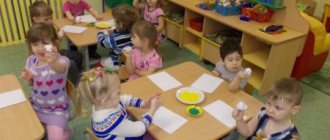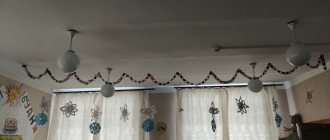Summary of the lesson on cognitive development “Medicinal plants”
Summary of the lesson on cognitive development “Forest Pharmacy”Objectives: 1. To introduce children to the concept of “Medicinal plants” and the benefits they bring to people. 2. Develop logical thinking, memory, attention. 3. To consolidate children’s knowledge about plants and their importance in the life of the Planet. 4. Cultivate a caring attitude towards plants and love for their native land.
Material: - visual material: drawings depicting medicinal plants, trees; — handouts: task cards.
Progress of the lesson:
Educator: Hello, guys! Today we have an unusual activity. Guys, listen to the riddle. If you solve it, you will understand what we are going to talk about today: They are different: Useful, dangerous, Beautiful, fragrant, With leaves, prickly. Medicines are replaced
And they give us a delicacy, And they give us tea to drink, And they even build a house, They are the creations of the earth. We call them...... (plants) - Please list the plants that you know? Children's answers (grasses, bushes, trees, flowers).
- Why are they called plants? Children's answers (plants have roots, stems, leaves, flowers, fruits)
— Guys, are plants living or nonliving? Children's answers (live)
- Why are they alive? Children's answers (they grow, breathe, eat, reproduce, die)
—Where do so many different plants grow? Children's answers (in the forest, in the meadow, in the field, in the front garden)
Today we will talk about medicinal plants. Without plants, life on the planet would not exist. Plants not only help all living things breathe, but also help them heal from diseases. Listen to poems about them.
The forest is like a fairy-tale kingdom, There are medicines growing all around. In every weed, in every branch - And medicines and pills.
Treatment with plants originated in ancient times. There were no pills or patches back then, but people were sick: they caught colds and were injured, they had headaches and stomach aches. People began to notice that sick animals left to find some kind of grass, which, after eating, they recovered. So man began to seek help from different plants. Or maybe someone knows a medicinal plant? Children's answers (mother - and - stepmother, plantain, nettle, dandelion)
Look at this plant. Who knows what it's called?
Children: Coltsfoot.
The teacher shows an illustration. - Look at the picture: it’s as if the sun scattered its little children across the clearing. Educator: Do you know why it has such a strange name? Children's answers.
Educator: Correct. The lower part of the leaf is covered with dense white hairs. From the inside they are soft, light, velvety. If you stroke it with your hand, you will feel softness and warmth. As if my mother had caressed me. And the upper part of the leaf is hard, smooth, cold. Like the touch of a stern stepmother. This is the very first spring flower. And what appears in front of the coltsfoot - leaves or flowers?
Children: Flowers.
Educator: They say that he is in such a hurry to appear in the light that he does not have time to put out his leaves. Coltsfoot flowers can predict the weather. At night and in bad weather, the flower tightly closes its petals. People prepare decoctions from these flowers and use them to treat coughs.
Physical school
Children squat, pretending to be unopened flower buds. The teacher says: “One-two-three, the flowers have grown!” Children slowly rise up, raise their arms up, and open their fingers.
They reached high towards the sun: They stretched on their tiptoes, looking up. They felt nice and warm! The breeze flew by and the stem swayed. Swing your arms left and right above your head. They swung to the left - they bent low. Lean to the left. They swung to the right - they bent low. Lean to the right. Wind, run away! They shake their fingers. Don't break the flowers! They squat. Let them grow, grow, Slowly rise, lift up Bring joy to the children! hands up, fingers open.
Listen to the riddle:
The doctor grew up near the road, he treats sick legs. Educator: Children, did you find out what kind of plant this is?
Children: Plantain.
Educator: Why is it called that?
Children: Plantain grows near roads.
Educator: It has hard and elastic leaves. Plantain is called a traveler grass. Why did he get such a nickname? What feature does its seeds have? Children's answers.
Educator: Tiny plantain seeds become sticky from rain or dew. Glued to the feet of people or the paws of animals, they travel with us, and the plantain easily moves to other places. What can plantain help us with? Children: It heals wounds.
Educator: It is applied to cuts, abrasions, and insect bites.
Listen to another riddle:
Oh, don't touch me, I'll burn you without fire. What plant are we talking about? Children: Nettle
Educator: But why do they say that nettle burns? Children's answers.
Educator: Yes, you are right: the stem and leaves of nettle are lined with stinging hairs, the sharp ends of which are very fragile. Each hair is like a needle on a syringe. There is a caustic liquid inside the hairs. If you touch it, you get injections. How do you think it is used? It is used to stop bleeding, used to heal wounds, an infusion of nettle leaves is used to gargle for sore throats, and also to strengthen hair. Do you know that nettle can not only cure, but also feed. Nettle leaves are edible. Now listen to the poems and recognize this plant:
The sun dropped a golden ray. The first dandelion grew up, young. It has a wonderful golden color. He is a big sun Small portrait.
On the lawn, where the bushes are, Bright yellow flowers. We woke up with the sun and stretched sweetly. The mosquitoes were surprised: There are no flowers, only balls, Delicate, fluffy, Light silver. A breeze ran past, The wind shook the balloons, And a row of parachutes flies behind them.
Dandelion flowers are dazzling yellow! And our lawn is burning, Like a fairy-tale bowl, Where the sun splashes on the round bottom!
Children: Dandelion
Educator: Flowers, like little suns, open in good weather and close when it’s cloudy. But the dandelion bloomed and what happens to it? Children's answers.
Educator: That's right, seeds appear attached to fluffy white tufts, which are easily blown away by the wind. That's why they called it that - dandelion. Let's imagine that we have white caps in our hands, let's blow on them, first barely, then harder, and then strongly, strongly, until all the parachutes fly away.
Dandelion is also medicinal. It is used as a means to lower the temperature. Dandelion can be eaten. Soups and salads are made from young leaves, jam is made from flowers, and dandelion coffee is made from roots.
Game “Collect medicinal herbs”
Illustrations of medicinal herbs in the form of a puzzle that need to be assembled Children, tell me, only herbs can be medicinal?
Children: No.
Educator: Who knows this bush?
Children: Raspberry.
Educator: Surely each of you was treated with tea with raspberry jam. It helps cure colds. What trees do you know that have medicinal properties?
The teacher shows illustrations. Children name familiar trees: linden, birch, rowan, oak.
There are so many plants and trees that can help us cope with diseases, but this is only a small part of all the riches of our Nature!
Nature happily gives us all her gifts, and in return she asks that we take care of her and not pick a single flower in vain, because it can cure someone! Let's say to our nature - thank you very much! And let's try never to get sick!


